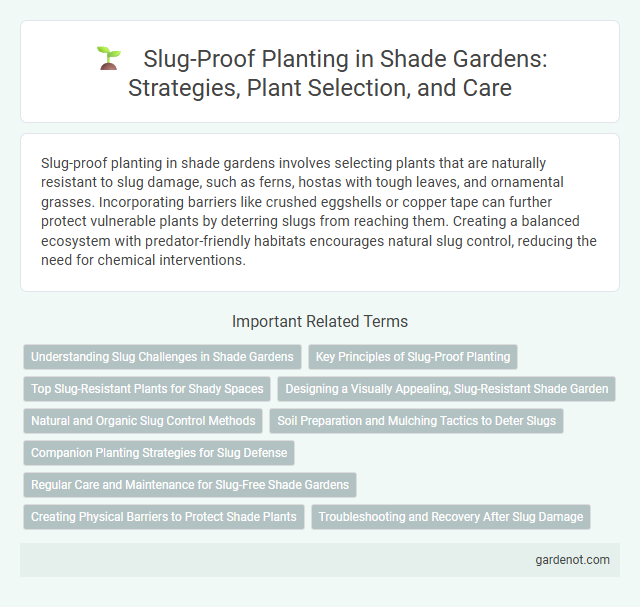Slug-proof planting in shade gardens involves selecting plants that are naturally resistant to slug damage, such as ferns, hostas with tough leaves, and ornamental grasses. Incorporating barriers like crushed eggshells or copper tape can further protect vulnerable plants by deterring slugs from reaching them. Creating a balanced ecosystem with predator-friendly habitats encourages natural slug control, reducing the need for chemical interventions.
Understanding Slug Challenges in Shade Gardens
Slug challenges in shade gardens primarily arise due to the moist, cool environment favored by slugs, which supports their activity and reproduction. Dense shade and organic mulch create ideal hiding spots, leading to increased slug populations that damage tender foliage and young plants. Recognizing these habitat preferences enables gardeners to implement slug-proof planting strategies by selecting resistant plant varieties and modifying garden conditions to reduce slug-friendly environments.
Key Principles of Slug-Proof Planting
Effective slug-proof planting relies on selecting resilient, slug-resistant plants such as ferns, astilbes, and hostas with tough or hairy foliage that deters feeding. Maintaining dry, well-drained soil and minimizing dense mulch layers reduce slug habitats and limit moisture retention, crucial for discouraging slug activity. Incorporating natural predators like ground beetles and employing physical barriers such as copper tape further enhance slug control in shade gardens.
Top Slug-Resistant Plants for Shady Spaces
Slug-proof shade gardens thrive with plants like ferns, hostas, and astilbes, which possess natural slug resistance due to their tough or hairy leaves. Incorporating herbs such as mint, thyme, and lavender also deters slugs effectively, creating a barrier around more vulnerable plants. Choosing these top slug-resistant varieties ensures a lush, healthy garden in shady areas with minimal slug damage.
Designing a Visually Appealing, Slug-Resistant Shade Garden
Incorporate slug-resistant plants such as hostas with tough leaves, ferns, and astilbes to create a lush, shade garden that deters slugs naturally. Utilize textured foliage and varying plant heights to add visual interest and reduce slug habitat. Strategically place mulch like cedar chips or gravel to minimize moisture retention, making the environment less inviting to slugs while maintaining an attractive, healthy garden.
Natural and Organic Slug Control Methods
Natural and organic slug control methods for shade gardens include planting slug-resistant varieties such as ferns, hostas with tougher leaves, and astilbes to reduce damage. Introducing natural predators like ground beetles, frogs, and toads helps maintain slug populations under control without chemicals. Using organic barriers such as crushed eggshells, diatomaceous earth, or copper tape around plants creates physical deterrents while maintaining a healthy garden ecosystem.
Soil Preparation and Mulching Tactics to Deter Slugs
Effective slug-proof planting in shade gardens begins with well-prepared soil enriched with organic matter, promoting healthy plant growth that withstands slug attacks. Mulching tactics such as using coarse, dry materials like pine needles or gravel create physical barriers, making it difficult for slugs to reach plants. Avoiding moisture-retentive mulches helps reduce slug habitat, minimizing their presence and damage in shady, damp environments.
Companion Planting Strategies for Slug Defense
Slug-proof planting in shade gardens can be effectively achieved through companion planting strategies that deter slugs naturally. Plants like lavender, rosemary, and fennel emit strong scents that repel slugs and protect vulnerable companions such as hostas, ferns, and astilbes. Incorporating alliums and mint among shade-tolerant plants creates a hostile environment for slugs, reducing damage and promoting healthier garden growth.
Regular Care and Maintenance for Slug-Free Shade Gardens
Regular care and maintenance are essential for slug-proof planting in shade gardens, including consistent removal of slug-friendly debris and monitoring moisture levels to reduce habitat suitability. Mulching with coarse materials like crushed eggshells or copper barriers can deter slugs while maintaining soil health. Frequent inspection and timely handpicking of slugs help maintain a slug-free environment, preserving the vitality of shade-loving plants.
Creating Physical Barriers to Protect Shade Plants
Creating physical barriers such as copper tape, crushed eggshells, or diatomaceous earth around shade plants effectively deters slugs by interrupting their movement. Installing raised beds with well-drained soil and using coarse mulch materials like pine needles or gravel further reduces slug access in shaded garden areas. Combining these strategies ensures a slug-proof environment that protects vulnerable shade-loving plants from damage.
Troubleshooting and Recovery After Slug Damage
Slug-proof planting involves selecting resilient shade garden plants like ferns, hostas with thick leaves, and astilbes to minimize damage. To troubleshoot slug infestations, inspect plants daily for slime trails and holes, then apply organic slug pellets or use barriers like crushed eggshells. After slug damage, prune affected foliage promptly and reinforce plant health through proper watering and mulch replacement to accelerate recovery.
Slug-proof planting Infographic

 gardenot.com
gardenot.com